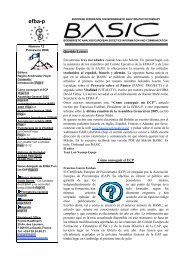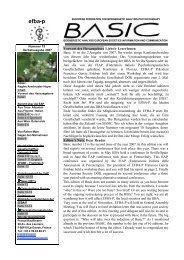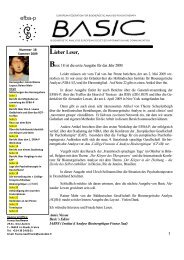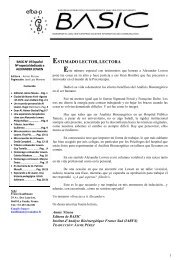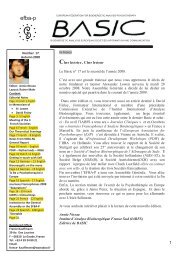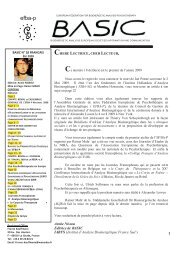December 2004 - European Federation for Bioenergetic Analysis ...
December 2004 - European Federation for Bioenergetic Analysis ...
December 2004 - European Federation for Bioenergetic Analysis ...
Create successful ePaper yourself
Turn your PDF publications into a flip-book with our unique Google optimized e-Paper software.
psychotherapy would then be to analyse the deficit, trauma or unresolved conflict, find some<br />
verbal and physical interaction to bring them out and help the patient find a means to heal.<br />
Lowen has described in many vignettes how he goes about; in fact he has also developed what<br />
is known as “body reading”, whereby he practically can read the character structure of a<br />
person by analysing the body structure and muscular tension pattern. His theoretical and<br />
practical concepts are all entirely based on personal observations and are in need of scientific<br />
proofs. The section on research will show that the bioenergetic community has been actively<br />
engaged since a few years to fill this gap.<br />
1.3. Applications<br />
From the above it is clear that BA is a <strong>for</strong>m of body psychotherapy useful <strong>for</strong> adults suffering<br />
from neurotic and psychosomatic disorders. How useful it is <strong>for</strong> psychotics is unknown at the<br />
present time, as we have no publications yet referring to the treatment of these disorders. Also<br />
the application of BA to children and their disorders (Ventling 2001) is still in the beginning,<br />
but publications begin to appear. From inquiries and research data (<strong>for</strong> more details see 1.4.<br />
on Research) we know that most our adult patients can be classified according to the ICD-10<br />
as belonging to the class F4 e.g. suffering from neurotic disorders, such as phobic and panic<br />
disorders, anxieties, compulsive disorders, adjustment problems, depressions with and<br />
without psychosomatic complications etc. A smaller fraction suffers from personality and<br />
behaviour disorders, and are classified as F6; about the same proportion suffering from<br />
affective disorders we can classify as F3. (Gudat 1997; Ventling & Gerhard 2000; Bertschi<br />
2003).<br />
1.4. Research<br />
Historically speaking <strong>for</strong> many years no questions were asked whether BA was an effective<br />
<strong>for</strong>m of psychotherapy, what exactly the training of the therapists was based on, what the<br />
therapist population or <strong>for</strong> that matter the patient population consisted of, whether the<br />
psychotherapeutic techniques followed definite concepts or rules and on what these depended,<br />
etc. etc. Many such questions were asked in recent years from state health departments, health<br />
insurances, health laws in various countries and thus became often a political issue. They<br />
were also asked from within the bioenergetic community. While <strong>for</strong> years it was the custom to<br />
publish success stories of psychotherapies (not just in BA!) in <strong>for</strong>m of vignettes or entire case<br />
histories, this was considered proof enough that the modality of psychotherapy described was<br />
reliable and there<strong>for</strong>e commendable.<br />
3



